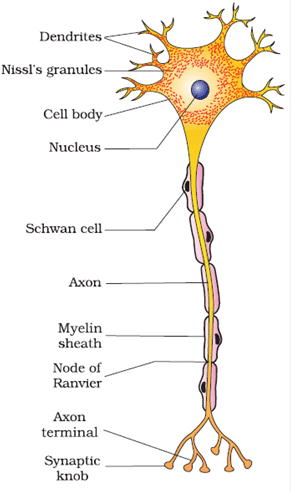NEET Exam > NEET Tests > Biology Class 11 > Test:Neuron - NEET MCQ
Test:Neuron - NEET MCQ
Test Description
10 Questions MCQ Test Biology Class 11 - Test:Neuron
Test:Neuron for NEET 2025 is part of Biology Class 11 preparation. The Test:Neuron questions and answers have been
prepared according to the NEET exam syllabus.The Test:Neuron MCQs are made for NEET 2025 Exam. Find important
definitions, questions, notes, meanings, examples, exercises, MCQs and online tests for Test:Neuron below.
Solutions of Test:Neuron questions in English are available as part of our Biology Class 11 for NEET & Test:Neuron solutions in
Hindi for Biology Class 11 course. Download more important topics, notes, lectures and mock
test series for NEET Exam by signing up for free. Attempt Test:Neuron | 10 questions in 10 minutes | Mock test for NEET preparation | Free important questions MCQ to study Biology Class 11 for NEET Exam | Download free PDF with solutions
Test:Neuron - Question 1
Which type of neuron is found in the retina of the eye and has one axon and one dendrite?
Detailed Solution for Test:Neuron - Question 1
Detailed Solution for Test:Neuron - Question 2
Detailed Solution for Test:Neuron - Question 3
Detailed Solution for Test:Neuron - Question 4
Detailed Solution for Test:Neuron - Question 5
Detailed Solution for Test:Neuron - Question 6
Test:Neuron - Question 7
Which of the following generally transmit nerve inpulse only to the cyton ?
Detailed Solution for Test:Neuron - Question 7
Detailed Solution for Test:Neuron - Question 8
Detailed Solution for Test:Neuron - Question 9
Test:Neuron - Question 10
Which part of the neuron is responsible for transmitting nerve impulses away from the cell body?
Detailed Solution for Test:Neuron - Question 10
|
180 videos|362 docs|148 tests
|
Information about Test:Neuron Page
In this test you can find the Exam questions for Test:Neuron solved & explained in the simplest way possible.
Besides giving Questions and answers for Test:Neuron, EduRev gives you an ample number of Online tests for practice






















